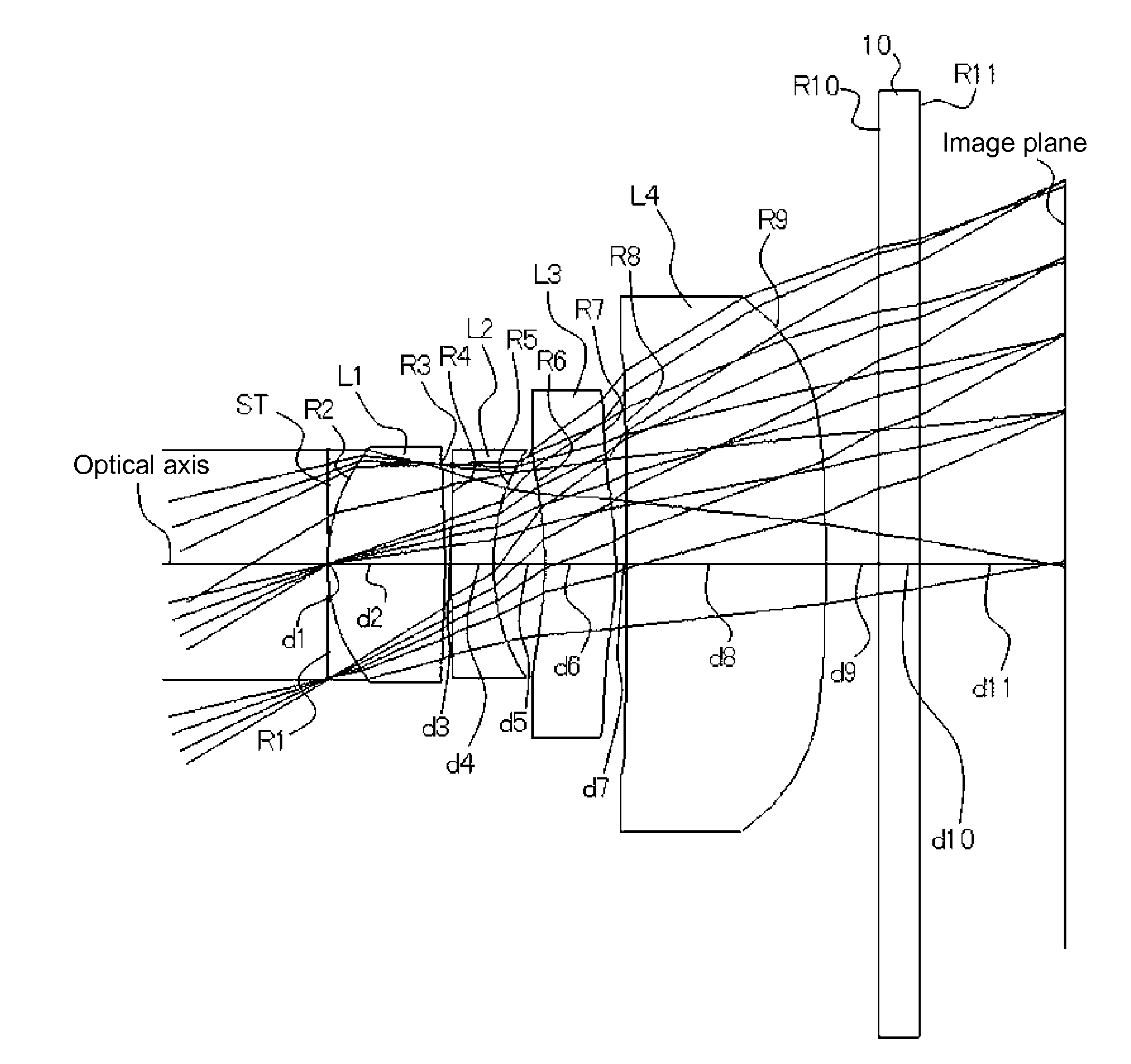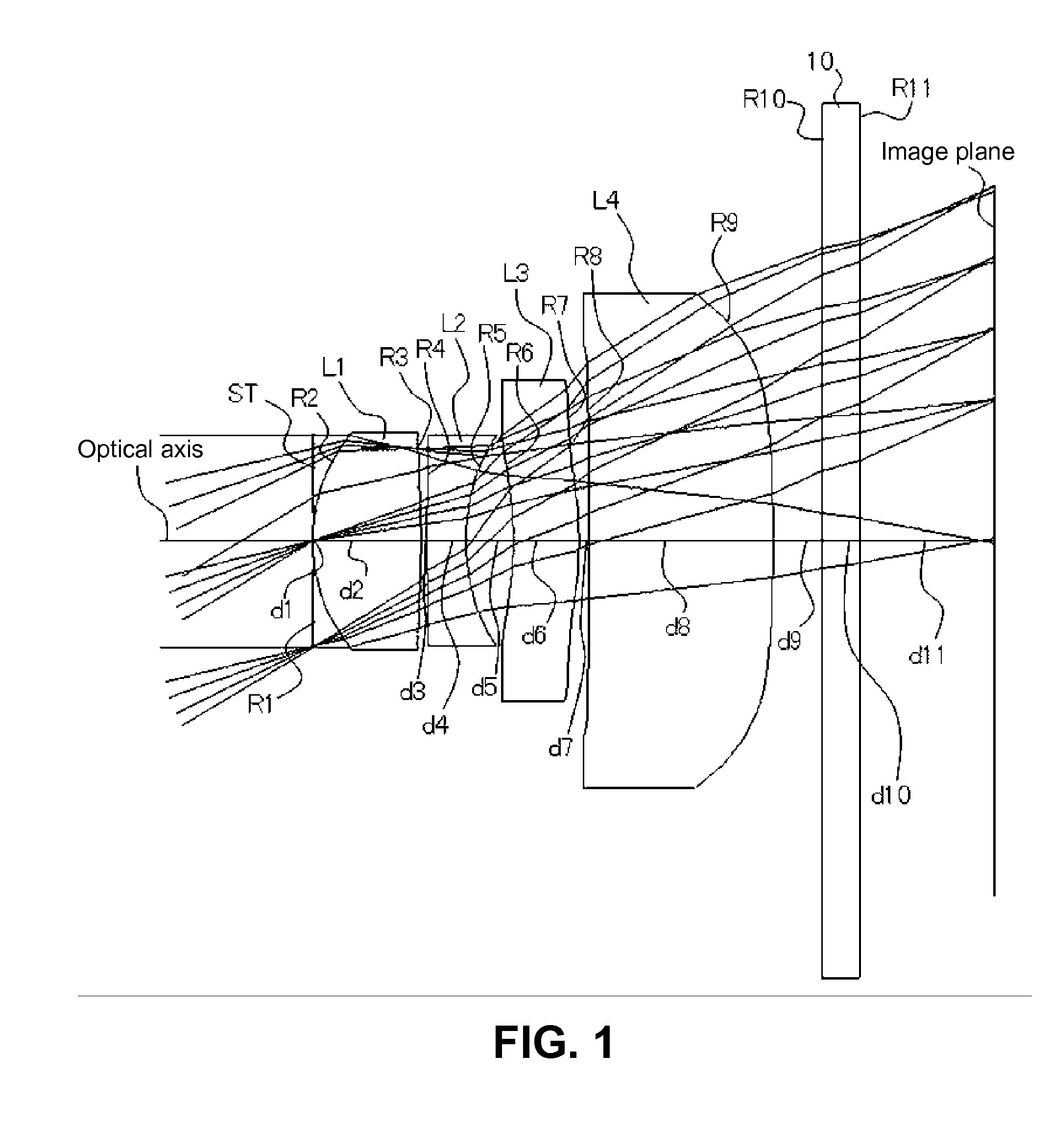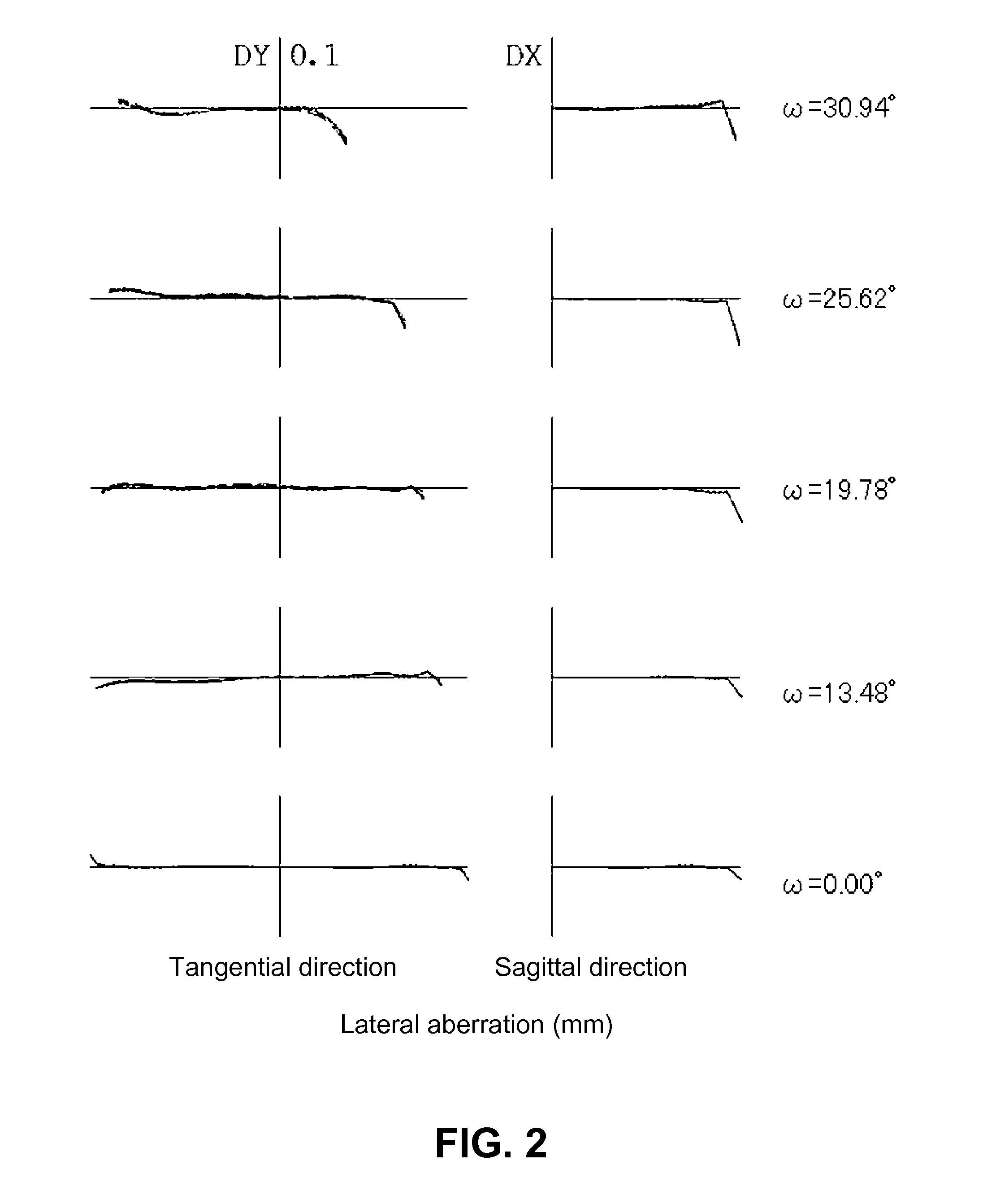Imaging lens
- Summary
- Abstract
- Description
- Claims
- Application Information
AI Technical Summary
Benefits of technology
Problems solved by technology
Method used
Image
Examples
numerical example 1
[0076]The basic lens data are as follows:
f = 4.792 mm, Fno = 2.800, ω = 30.94°Unit mmSurface dataSurface number iRdNdνd(Object)∞∞ 1 (stop)∞0.0000 2*1.4200.87001.5247056.2 (=νd1) 3*−7.2200.0500 4*16.1500.31601.6142026.0 (=νd2) 5*1.6600.3820 6*−3.0600.53001.5247056.2 (=νd3) 7*−3.1100.0800 8*80.0001.48901.5247056.2 (=νd4) 9*−24.0000.400010∞0.30001.5163364.1211∞1.0924(Image plane)∞f1 = 2.343f2 = −3.038f12 = 4.878f34 = 26.959da = 0.512L14 = 3.717Aspherical surface dataSecond surfacek = 7.124138E−01, A4 = −3.255467E−02, A6 = −3.345029E−02,A8 = 6.443935E−02, A10 = −8.410124E−02Third surfacek = 7.650370E+01, A4 = 6.319932E−03, A6 = 3.587828E−01,A8 = −3.390403E−01, A10 = −3.205488E−02Fourth surfacek = 0.000000, A4 = −7.977956E−02, A6 = 2.264327E−01,A8 = 1.561367E−01, A10 = −7.007116E−01Fifth surfacek = −7.378725E−01, A4 = −5.955688E−02, A6 = 3.026794E−01,A8 = −1.537807E−01, A10 = −8.573522E−02Sixth surfacek = 0.000000, A4 = 7.704037E−03, A6 = 9.406414E−02,A8 = −3.842276E−02, A10 = −2.456153E...
numerical example 2
[0081]The basic lens data are as follows:
f = 4.792 mm, Fno = 2.800, ω = 30.94°Unit mmSurface dataSurface number iRdNdνd(Object)∞∞ 1 (stop)∞0.0000 2*1.4120.85471.5247056.2 (=νd1) 3*−7.2120.0500 4*17.5130.36291.6142026.0 (=νd2) 5*1.6770.3525 6*−3.2890.58351.5247056.2 (=νd3) 7*−3.3260.1084 8*232.7371.39421.5247056.2 (=νd4) 9*−45.8630.400010∞0.30001.5163364.1211∞1.0252(Image plane)∞f1 = 2.330f2 = −3.046f12 = 4.724f34 = 44.905da = 0.511L14 = 3.706Aspherical surface dataSecond surfacek = 7.131351E−01, A4 = −3.329571E−02, A6 = −3.025131E−02,A8 = 6.952348E−02, A10 = −9.095330E−02Third surfacek = 7.004994E+01, A4 = 2.254029E−03, A6 = 3.700801E−01,A8 = −3.337891E−01, A10 = −7.588148E−02Fourth surfacek = 0.000000, A4 = −8.123492E−02, A6 = 2.096769E−01,A8 = 1.582786E−01, A10 = −6.600632E−01Fifth surfacek = −9.407782E−01, A4 = −6.543800E−02, A6 = 3.124348E−01,A8 = −1.747500E−01, A10 = −3.055272E−02Sixth surfacek = 0.000000, A4 = −7.554145E−03, A6 = 1.039733E−01,A8 = −5.658820E−03, A10 = −2.54429...
numerical example 3
[0084]The basic lens data are as follows:
f = 4.780 mm, Fno = 2.800, ω = 31.00°Unit mmSurface dataSurface number iRdNdνd(Object)∞∞ 1 (stop)∞0.0000 2*1.4110.86101.5247056.2 (=νd1) 3*−7.2400.0500 4*17.4160.36831.6142026.0 (=νd2) 5*1.6800.3500 6*−3.3080.59451.5247056.2 (=νd3) 7*−3.3640.1068 8*234.6981.37431.5247056.2 (=νd4) 9*−50.3690.400010∞0.30001.5163364.1211∞1.0069(Image plane)∞f1 = 2.330f2 = −3.054f12 = 4.688f34 = 49.155da = 0.507L14 = 3.705Aspherical surface dataSecond surfacek = 7.124973E−01, A4 = −3.340274E−02, A6 = −3.029348E−02,A8 = 6.979722E−02, A10 = −9.045849E−02Third surfacek = 6.983134E+01, A4 = 2.332465E−03, A6 = 3.712007E−01,A8 = −3.327910E−01, A10 = −7.740465E−02Fourth surfacek = 0.000000, A4 = −8.121136E−02, A6 = 2.083994E−01,A8 = 1.571260E−01, A10 = −6.573071E−01Fifth surfacek = −9.757836E−01, A4 = −6.636112E−02, A6 = 3.116588E−01,A8 = −1.762056E−01, A10 = −3.366125E−02Sixth surfacek = 0.000000, A4 = −8.748924E−03, A6 = 1.037168E−01,A8 = −3.758805E−03, A10 = −2.28558...
PUM
 Login to View More
Login to View More Abstract
Description
Claims
Application Information
 Login to View More
Login to View More - R&D
- Intellectual Property
- Life Sciences
- Materials
- Tech Scout
- Unparalleled Data Quality
- Higher Quality Content
- 60% Fewer Hallucinations
Browse by: Latest US Patents, China's latest patents, Technical Efficacy Thesaurus, Application Domain, Technology Topic, Popular Technical Reports.
© 2025 PatSnap. All rights reserved.Legal|Privacy policy|Modern Slavery Act Transparency Statement|Sitemap|About US| Contact US: help@patsnap.com



